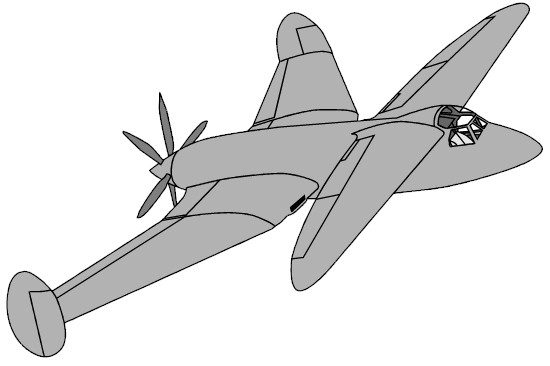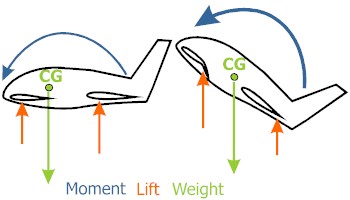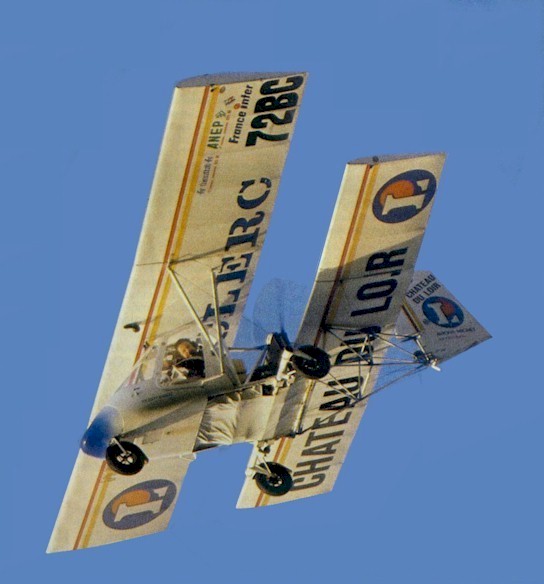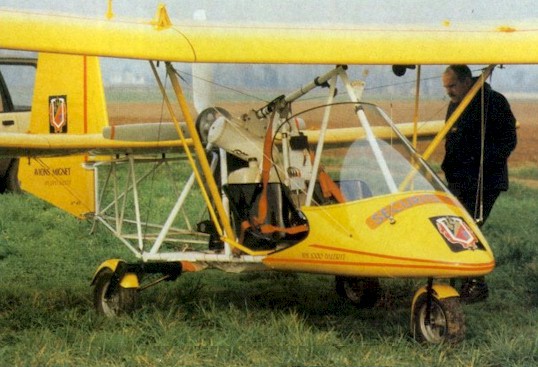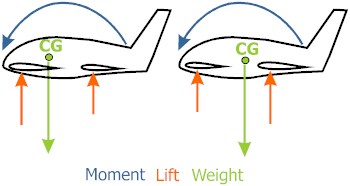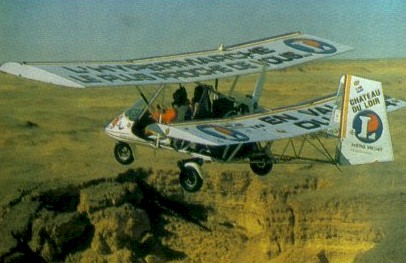 |
||||
|
||||
He got his inspiration after seeing the Westland P12 "Duo-Mono". This plane, which was a conventional airplane with a large tail, have the possibility to place the center of gravity (CG) more backwards. It wasn't a tandem, but that idea began to get shaped in Miles' brain. Persons who now think "Hey, it was a Frenchman who made the first tandem" need to read further. Mignet is also included in this page.
I found in Air Enthusiast / number five (a magazine) the following list of advantages Miles thought to create with his tandem.
This may sound like Chinese to some. So, let us review the lines.
|
||||
An aircraft that can still maneouver at low speeds while it's opponent cannot, may well win out in a turning fight). As to landings, increased Ci can also decrease the nose-up attitude during landings, making the runway/carrier deck more easily visible to the pilot. The US Navy made a hybrid out of this concept in the F-8 Crusader, by tilting the wing several degrees during landing to allow the pilot to remain almost level during the approach, thus allowing him a better view of the carrier deck then would have been possible otherwise given the high stalling speed of the aircraft. I got another remark about maneuverability by Evan L. Mayerle. It is not Cl related, but interesting to know anyhow. A: "Well, first of all, concentrating all your heavy items, like the engine, near the cg is going to reduce your moments of inertia so that a given input will get more output. By the same token, splitting the lift between two wings, especially if the split can be controlled or varied, can also enhancemaeuvarability. I don't think that an increased Cl can, of itself, increase maneuverability; however, it's been decades since I took any Aero. classes and my work has been mostly detail design, not overall configuration." The time when I did receive this mail the text above was not yet placed. So he could not have known about the relation J.T. Wenting mentioned. |
||||
|
||||
|
||||
Here two situations can be seen. First the cruising condition, second the tandem during landing while using a higher angle of attack. The lift forces have shifted backwards. The rear wing lift force is further away from the CG and generates a larger moment than while cruising. The first wing lift force is closer to the CG and has to be larger to compensate the moments. But anyway, here with tandems we use LIFT. Conventional airplanes have to use more downwards pushing force at the tail. George Miles was very, very enthusiast about this tandem idea. Seeing his advantages, who wouldn't be? But would the plane be stable? He still had to prove. Miles knew this and made a proof-of-concept airplane to get support for his Fleet fighter proposal. He made the M 35 in 1942 as a private venture without the knowledge of the Ministry of Aircraft Production. Roll-out was at the end of April 1942 after only 6 weeks from the start of the build up. This was possible due to the extensive use of existing parts (NASA today uses this strategy as much as possible when making their X-planes). |
||||
|
||||
Miles M 35. A proof of concept airplane. Build in six weeks. Miles flew the plane himself on its flight
flight. It nearly ended in disaster. It was very unstable around its pitch axis. Even
after ballasting, which improved stability, the overall result was still not so good. But
Miles thought it had proven his idea. Windtunnel tests would have showed this instability,
but I guess Miles was in a hurry. |
||||
|
||||
Miles M 39 B with its unusual engine configuration. After viewing the M39B the Ministry got interested in the tandem design and bought the plane to test it. Now let us see the situation. We have two wings. How would you position
the control surfaces? ... Miles did it as following: flaps on both wings, elevators on the
front wing, ailerons on the rear wing and rudders at the wingtips and there also was a
non-moving tail at the end of the fuselage. Elevators and ailerons were positioned next to
the flaps, which were placed next to the fuselage. But the thing that interested the Ministry was
its stall behavior. You couldn't stall the M39B if the flaps were placed in its neutral
position. The Ministry asked more tests to explore this non-stall behavior. Pilots founds
out that it got lost when flaps were being used. It was even so that if the M39B stalled,
it happened without warning! So it was good news and bad news. Later more about the good
news (when talking about the design of Henri Mignet). The M39B was a scaled down version of the bomber proposal of Miles. So it wasn't stressed for acrobatics. On one of the flight a pilot encountered some turbulence. He later said it felt like the cockpit wanted to break off. It will not be a surprise if I tell you that there were no orders for the M39. In fact, the whole specification B.11/41 lapsed. This story of a "new" (see later)
concept, which didn't get orders but was build twice without official support, shows that
a designer can sometimes be so enthusiast about his proposal, that he is blinded from the
fact that there is still a lot of work on the design. You might think now that the tandem concept isn't worth a penny. Well, you are wrong. There are some successful tandems out there. One of them is the "Pou de Ciel" (Flying Flea) of Henri Mignet. |
||||
|
||||
The Mignet HM 1000 Balerit, a later development of the first "Pou de Ciel" To my knowledge the first tandem was the "Pou de Ciel" (1933) of the Frenchman Henri Mignet. It was his fortheenth design. That's why it did received the designation HM-14. Compared to the design of Miles you can see the following differrences. The HM 14's front wing is larger than the rear wing. The horizontal distance between both wings is smaller. The single vertical is placed on the fuselages end. The pilot is positioned between the wings. A classic landinggear is used. The front wing does not have elevators, but the whole wing rotates. The engine was placed in the front. Using this configuration it made Mignet possible to create a compact, light, cheap, easy to build airplane. At the same time Henri Mignet wrote his book "Le sport de L' Air". This book also contained the plans to build a HM-14. The English translation sold over 6000 copies! Soon there was a real Flea fever. Abouot 600 FLying Fleas were built. All went well.. but then came the crashes. Several HM-14 fell out of the sky. The accidents were caused by a design mistake. Mignet placed the pilot behind the center of gravity (CG) and if a lighter pilot flew the airplane the nose couldn't be kept up. Several pilots dove to their death. Mignet quickly redsigned the HM-14 by adding a flap to the rear wing. Mignet created a nose-up with this flap, just like the flaps on the rear wing of the Libellula. But allready many countries grounded the Flying Fleas. And quickly the Flea fever died. But this didn't stop Mignet. He kept designing tandems. I found some info about the HM 1000
"Balerit", a very popular ultra light two seater (empty weight 174 kg (383 lbs).
I am not sure that this one is designed by Henri, it could be done by a son. Kruhmin
Nikolas did confirm this thought. |
||||
|
||||
Sure is a eye-catcher this HM 1000 Balerit. Like most Mignet designs it has two controlled axis (no ailerons). And I noticed that there is no longer a flap on the rear wing. So I guess that the designer placed the pilots (seated next to each other) on top of the CG. After this bit of history, let's look at the design of the HM 1000. It doesn't stall either. We sure need to look deeper into this item. Here the elevators are placed in the wing, which stalls first. When stall occures, the elevator can not longer keep the nose up. So, the nose drops lightly. As soon as the elevator gets lift again, the elevator works again and the nose rises again. This doesn't lead to a stall with a severe heightloss, but to a controllable (but steeper than normal) descent in a wave shape. And that sounds rather safe to me for a beginner pilot ( and all the others). Marske uses this system as well on his flying wings. Go see his designs at www.continuo.com/marske. His flying wings stall first at the section next to the fuselage. Now guess what is located in that section. Right,... the elevators! Now let's see the other design features on the HM 1000. Miles choose for a larger rear wing, Mignet for a larger front wing. What is the advantage of Mignets choice? Well, here I have no books or articles about. So, let's use logic. Miles designs had a CG, which was placed nearer to the rear. Mignets CG is placed more to the front. This fact influences the placement of the rudder. Miles couldn't place his moving rudder on the end of the fuselage. It wouldn't be effective enough. He had to place the rudders at the wingtips (the rudder on the end of the fuselage wasn't a moving one). Mignet placed his rudder a bit after the rear wing. The distance between rudder and CG is larger and will be mor effective. I guess it does take less extra weight than the reinforcement needed to place the rudders on the wingtips. Anyhow, the distance between rudder and CG will be smaller on a tandem than on a conventional airplane. So, a tandem will always have a larger tail. The Quicky is a exception. The designer did make the fuselage longer and placed a normal tail.
|
||||
|
||||
Here you can see the basic differences between a tandem with a larger
first wing and a tandem with a larger rear wing. The place of the CG is different and the
distance between the CG and the tail is different. The distance between both wings is smaller in Mignets design in relation to the Libellula. The conciquences of this decision are positive and negetive. Positive news is that the design is very compact and very light. Like a testpilot mentioned before, Miles had problems with the fuselage of the Libellula. His fuselage should be made heavier to hold the high lift forces, which are placed further away of eachother. If a tandem would be made with a looong and light fuselage and a large distance between both wings, it could snap in two on the first turbulence. Negative news is that, if the distance between the wings is short, the distance between CG and the elevator is also short. So you would need more deflection of the elevator to steer the airplane around its pitch-axis. Trim drag becomes high. High performance will not be possible in this configuration. But it makes a good configuration for a cheap, light, compact airplane. The sales of Mignets prove it! Oh yes, I nearly forgot. The HM 1000 has a very unusual place for its signle propeller. It is placed between both wings. It makes a centered weight position (by placing the engine near the center) possible. |
||||
|
||||
The HM 1000 Balerit did prove his value in several events. By some luck I ran into the official site of the Mignet-plant. It is http://avions.mignet.free.fr/ . I did see for the first time that there is a more advanced version of the Balerit, the Cordouan. It has a enclosed cockpit now, which also was a option on the Balerit, but here there is no longer a main tube frame. You could call it a fully "tranditional" version of a tandem.
|
||||
 |
 |
|||
The Mignet Cordouan, the advanced version of the Balerit. If you like to know more about the Mignet, please contact the Mignet-plant at avions.mignet@free.fr Want to see more Flying Fleas? Go see www.valkyrie.net/~flyingflea/. Here is a picture gallery of finished home-builded Flying Fleas.
|
||||

